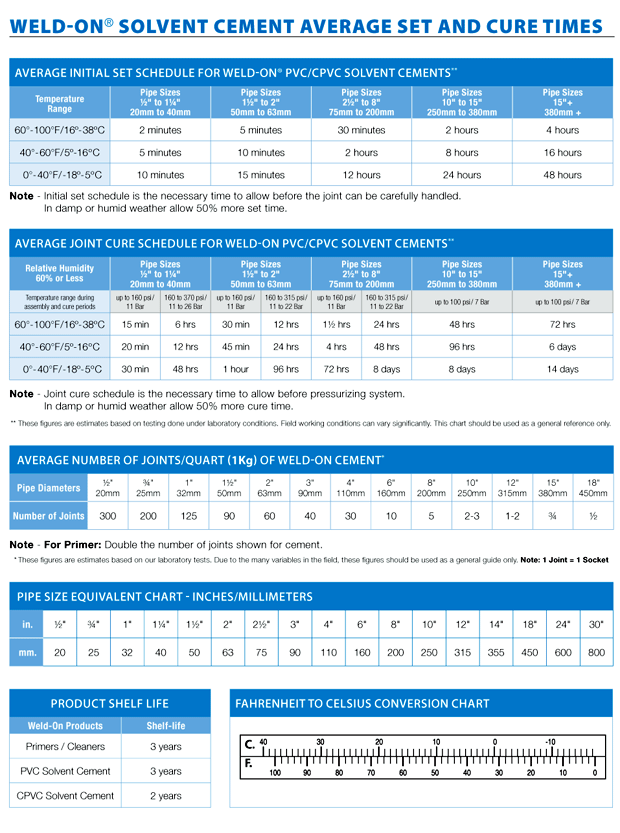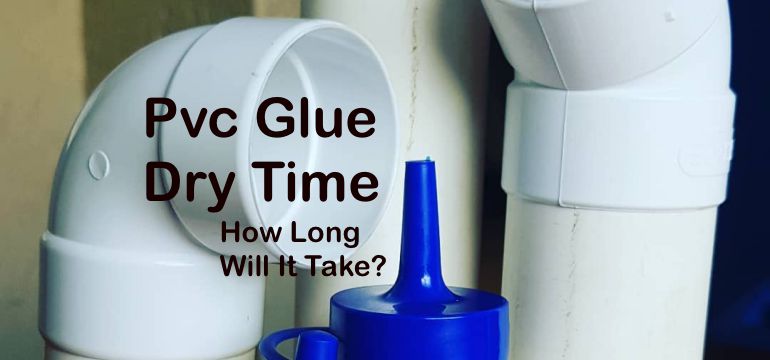PVC glue typically takes 24 hours to fully dry. However, it may be ready for handling within 30 minutes to an hour after application, depending on the specific product and environmental conditions.
PVC glue, also known as solvent cement, is commonly used to bond PVC pipes and fittings and is essential for creating secure and leak-proof connections. Understanding the drying time of PVC glue is important to ensure the effectiveness and longevity of the bond between PVC components.
We will explore the factors influencing the drying time of PVC glue and provide tips for achieving the best results when using this adhesive for your PVC piping projects.
Table of Contents
Understanding Pvc Glue Drying
PVC glue drying is a crucial aspect to consider when working on PVC pipe projects. Proper understanding of how long PVC glue takes to dry is essential for successful bonding.
Factors Affecting Drying Time
- Ambient temperature: Warmer temperatures speed up drying time.
- Humidity levels: Higher humidity may slow down the drying process.
- Type of PVC glue: Some formulas dry faster than others.
Importance Of Proper Drying
- Ensures a strong bond: Proper drying leads to a secure connection.
- Prevents leaks: Incomplete drying can result in leaks and weak joints.
- Maintains project integrity: Proper drying ensures the longevity of the PVC pipe structure.

Credit: weldon.com
Drying Time Of Pvc Glue
When it comes to working with PVC pipes, using PVC glue is a crucial step to ensure a strong and durable bond. But have you ever wondered how long it takes for PVC glue to dry? In this article, we will dive into the drying time of PVC glue, including normal drying time and extended drying time.
Normal Drying Time
Normal drying time refers to the average time it takes for PVC glue to dry under regular working conditions. Typically, PVC glue dries enough to handle within 15 to 30 minutes. However, it’s important to note that the drying time can vary depending on factors such as ambient temperature and humidity.
Before touching or putting any pressure on the glued joints, it is recommended to wait at least one hour to ensure a strong bond. This waiting time allows the glue to fully set and achieve its maximum strength. Remember, patience is key when it comes to working with PVC glue!
Extended Drying Time
Sometimes, you might come across situations where you need to allow for an extended drying time. This could be due to working in colder temperatures or dealing with larger pipe sizes. In these cases, it’s important to use a PVC glue specifically designed for extended drying time.
Glues with extended drying time can take up to 24 hours to fully dry and form a strong bond. This increased drying time allows the glue to penetrate and bond properly, ensuring a secure connection between the PVC pipes. Be sure to check the label of the PVC glue you are using to determine the recommended drying time.
In conclusion, the drying time of PVC glue is an important consideration when working with PVC pipes. While the normal drying time is around 15 to 30 minutes, it is advisable to wait at least one hour before handling or putting pressure on the glued joints. If an extended drying time is needed due to specific circumstances, be sure to use a PVC glue designed for such situations and follow the recommended drying time provided by the manufacturer.
Quick-drying Tips
Finding yourself in a DIY project involving PVC pipes can be both exciting and challenging. One vital aspect of working with PVC is knowing how long the glue takes to dry. Thankfully, there are ways to speed up this process. In this article, we will explore two key areas: optimal conditions for quick drying and tips for accelerating the drying process.
Optimal Conditions For Quick Drying
When it comes to ensuring that your PVC glue dries as quickly as possible, paying attention to the surrounding conditions is crucial. Here are some optimal conditions that will help expedite the drying process:
- Ambient Temperature: Maintaining a warm environment facilitates faster drying. Ideally, the temperature should be between 60°F (15°C) and 80°F (27°C).
- Adequate Ventilation: Good airflow encourages the solvent in the glue to evaporate, accelerating the drying process. Ensure the area is well-ventilated during and after gluing.
- Low Humidity: High humidity can significantly delay drying time. It is best to work in an area with humidity levels below 60% to prevent excess moisture from hindering the drying process.
- Proper Surface Preparation: Before applying PVC glue, make sure the surfaces are clean, dry, and free from any dirt or debris. This ensures better adhesion and speeds up drying.
Tips For Accelerating Drying
If time is of the essence, consider these tips to accelerate the drying time of PVC glue:
- Use Fast-drying Glue: Opt for fast-drying PVC glue varieties, specifically designed to reduce drying time without compromising the bond’s strength. These glues are formulated to evaporate more quickly.
- Apply Thin Layers: Instead of applying a thick layer of glue, it is advisable to spread thin layers on the PVC surfaces. Thin layers dry faster as the solvent evaporates more efficiently.
- Use a Fan or Heat Source: Place a fan or direct gentle heat, such as a hairdryer, towards the glued area to promote airflow and heat, aiding in expedited drying.
- Leave Sufficient Drying Time: Although these tips aim to speed up the process, it is essential to allow sufficient drying time as indicated on the PVC glue packaging. Rushing through may result in a weak bond.
By following these quick-drying tips, you can be confident that your PVC glue will dry in a timely manner, allowing you to move forward with your project efficiently. Remember to always prioritize safety, use proper tools, and consult product instructions!
Testing Pvc Glue Dryness
When working with PVC pipes, it’s crucial to allow sufficient time for the solvent cement or PVC glue to dry properly. Testing the dryness of PVC glue involves a couple of simple methods that can help ensure a secure bond for your plumbing or crafting projects.
Visual Inspection
- Inspect the glued joint for any visible signs of wetness or shininess.
- A completely dry PVC glue joint will appear matte and uniform in color.
- Any wet spots or glossy areas indicate that the glue hasn’t completely dried yet.
Touch Test
- Gently touch the glued joint with your finger.
- A fully dried PVC glue joint will feel dry to the touch without leaving any residue on your finger.
- If the joint is still tacky or sticky, it’s an indication that the glue is still drying.
Effect Of Temperature And Humidity
The drying time of PVC glue varies depending on the temperature and humidity levels. Higher temperatures and lower humidity can accelerate the drying process, while lower temperatures and higher humidity may prolong it. It is essential to consider these factors to ensure a proper and efficient bond.
Influence Of Temperature
Temperature plays a crucial role in determining how long PVC glue takes to dry. Hotter temperatures can accelerate the drying process, while colder temperatures can slow it down. The chemical reaction that occurs when PVC glue is applied to a joint and dries is exothermic, meaning it releases heat. This heat helps the glue bond the PVC pieces together.
In warmer temperatures, the heat generated by the chemical reaction speeds up the evaporation of the solvent in the glue. This results in a faster drying time, allowing you to move on with your project more quickly. However, using PVC glue in extremely high temperatures can also have negative effects, such as the glue drying too quickly and not forming a strong bond.
In contrast, colder temperatures can significantly slow down the drying process. The low temperatures impede the evaporation of the solvent, causing the glue to take longer to dry. If you’re working in a cold environment, it’s important to be patient and allow sufficient time for the glue to dry properly. Rushing the process may result in a weak bond that can compromise the structural integrity of your PVC joint.
Role Of Humidity
Humidity, or the amount of moisture in the air, also affects the drying time of PVC glue. High humidity levels can increase the amount of moisture in the air, which can delay the drying process. This is because the moisture in the air competes with the solvent in the glue for evaporation, slowing down the overall drying time.
If you’re working in a high-humidity environment, it’s essential to take extra precautions to ensure that the glue fully dries and bonds properly. Consider using a fan or dehumidifier to reduce the moisture in the air and expedite the drying process. Additionally, allowing sufficient drying time in such conditions is crucial to ensuring a strong bond between the PVC pieces.
On the other hand, low humidity levels can help accelerate the drying process. The drier the air, the faster the solvent in the glue evaporates, leading to a quicker drying time. However, it’s important to strike a balance because extremely low humidity can cause the PVC glue to dry too quickly, potentially resulting in a weak bond.

Credit: www.h2ouse.org
Safety Considerations
Handling Wet Pvc Joints
When working with PVC glue, it is crucial to ensure proper safety measures are in place to avoid accidents and mishaps. The handling of wet PVC joints requires careful attention to prevent any potential harm. It is essential to follow specific guidelines to maintain safety.
Avoiding Premature Disturbance
Another critical safety consideration when dealing with PVC glue is the avoidance of premature disturbance to the glued joints. Disturbing the joints before the glue has fully dried can lead to weakened bonds and potential failures. It is important to exercise caution and patience during this drying process to ensure the integrity of the PVC joints.
Utilizing Quick-drying Methods
PVC glue drying time can vary, requiring quick-drying methods. Let’s explore when it’s necessary to speed up the drying process and how to properly apply these methods.
When Quick Drying Is Necessary
Quick drying becomes essential when time is limited or when you need to proceed with the next steps promptly.
Proper Application Of Quick-drying Methods
- Use a fast-setting PVC glue for quicker drying times.
- Apply minimal glue to speed up the drying process.
- Utilize a hot air gun to accelerate the drying of the adhesive.
By implementing these techniques, you can expedite the drying time of PVC glue effectively.

Credit: www.angi.com
Frequently Asked Questions
How Long Should Pvc Glue Dry Before Turning On Water?
PVC glue should dry for at least 2 hours before turning on the water. It’s important to allow adequate time for the glue to set and create a secure bond. Rushing this process can lead to leaks and potential damage.
How Long After Gluing Cpvc Can You Turn Water On?
After gluing CPVC, wait at least two hours before turning on water to ensure proper adhesion.
How Long Does It Take For Red Hot Blue Glue To Dry?
Red hot blue glue typically dries within 15 to 30 seconds, providing quick and efficient bonding for piping applications.
How Long After Gluing An Abs Pipe Can I Run Water?
You can run water immediately after gluing an ABS pipe.
Read Next:
Conclusion
After learning about how long PVC glue takes to dry, it’s important to follow the manufacturer’s instructions for optimal results. Proper drying time ensures a strong bond for your PVC projects. Remember to allow sufficient time for curing before handling or putting stress on the glued parts.
Mastering this process will lead to successful PVC bonding projects.
